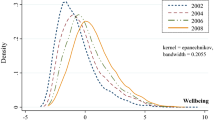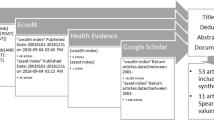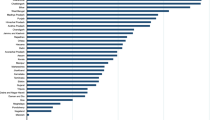Abstract
Despite a broad theoretical literature on multidimensional inequality and a widespread belief that welfare is not synonymous to income—not the least in a developing context—empirical inequality examinations rarely includes several welfare attributes. We explore three techniques on how to evaluate multidimensional inequality using Zambian household data on consumption, education, health and land. The examination indicates that level and changes in non-monetary inequality are at odds with consumption inequality. Moreover, assessment of a multidimensional index shows evidence of that dimensions of wellbeing compensate and reinforce each other with respect to inequality. However, a majority of the results using this technique are sensitive to the degree of substitution between attributes. In applying a stochastic dominance method few combinations fulfill the required dominance conditions. Accordingly, less imposed structure come at a cost. Clearly, sensitivity analyzes, explicitness and analyzes involving more than one technique are constructive in portraying multidimensional inequality.





Similar content being viewed by others
Notes
The multidimensional approach to poverty has also been addressed theoretically by several researchers; see Duclos et al. (2001) and Deutsch and Silber (2005). In contrast to the study of inequality, there are currently more empirical applications in this field, see e.g., Chambaz and Maurin (1998) and Maltzahn and Durrheim (2008).
We drop 265 households in 1998 and 161 households in 2004 from the original samples since these units do not have complete information concerning one or more of the variables used in the analysis. This represents a drop of 1.6 and 0.8%, respectively, of the original samples.
Detailed information of this procedure and estimation results are available from author upon request.
To ensure that empirical results are not driven by how we create the different partitions we will also use discrete partitions, where the dataset is divided into quintiles corresponding to 20% of the population.
These countries are the Central African Republic (0.61), Lesotho (0.63), Panama (0.55), South Africa (0.58) and Zimbabwe (0.57).
The Pearson’s test of correlation generates the same general result as above with the difference that the correlations are overall lower and that correlation between expenditures and land is positive, but insignificant.
For a test of statistical inference, a bootstrap procedure is used to generate estimates of the standard errors of M(0) and M(1). The bootstrapped samples mimic the empirical distributions of the LCMS II and LCMS IV survey samples.
The results of the Maasoumi index for all possible combinations of S2 and S3 are available upon request.
All results in this section are confirmed using a different discrete partition of the variables. In this case the dataset is divided into quintiles corresponding to 20% of the population.
References
Anand, S., & Sen, A. K. (2003). Concepts of human development and poverty: A multidimensional perspective. In S. Fukuda-Parr & A. K. Shiva Kumar (Eds.), Readings in human development: Concepts, measures and policies for a development paradigm. New Delhi: Oxford University Press.
Atkinson, A., & Bourguignon, F. (1982). The Comparison of multi-dimensioned distributions of economic status. The Review of Economic Studies, 49(2), 183–201. doi:10.2307/2297269.
Atkinson, A., & Bourguignon, F. (1987). Income distribution and differences in needs. In G. R. Feiwel (Ed.), Arrow and the foundation of the theory of economic policy. London: Macmillan.
Bazen, S., & Moyes, P. (2003). Comparisons of income distributions across heterogeneous populations. In J. A. Bishop & Y. Amiel (Eds.), Research in Economic Inequality, Vol. 9. Amsterdam: JAI-Elsevier Press.
Blackbory, C., & Donaldson, D. (1978). Measures of relative inequality and their meaning in terms of social welfare. Journal of Economic Theory, 18(1), 58–80.
Bourguignon, F. (1999). Comment to: Multidimensional approaches to welfare analysis by E. Maasoumi. In J. Silber (Ed.), Handbook on income inequality measurement. MA: Kluwer.
Chambaz, C., & Maurin, E. (1998). Atkinson’s and Bourguignon dominance criteria: Extended and applied to the measurement of poverty in France. Review of Income and Wealth, 44(4), 497–513. doi:10.1111/j.1475-4991.1998.tb00295.x.
Cowell, F. (2000). Measurement of inequality. In A. B. Atkinson & F. Bourguignon (Eds.), Handbook of income distribution. Amsterdam: Elsevier.
CSO—Central Statistical Office of Zambia. (1994). National Census of Agriculture 1990–92.
CSO—Central Statistical Office of Zambia. (1999). Living Conditions Monitoring Survey II.
CSO—Central Statistical Office of Zambia. (2005). Living Conditions Monitoring Survey IV.
Deaton, A. (1997). The analysis of household surveys: A microeconomic approach to development policy. Baltimore, MD: Johns Hopkins University Press.
Deutsch, J., & Silber, J. (2005). Measuring multidimensional poverty: An empirical comparison of various approaches. The Review of Income and Wealth, 51(1), 145–174. doi:10.1111/j.1475-4991.2005.00148.x.
Duclos, J.-Y., Sahn, D., & Younger, S. D. (2001). Robust multidimensional poverty comparisons. Working Paper no. 0115, Université Laval, Département d’Économie, Québec.
Hirschberg, J. G., Maasoumi, E., & Slottje, D. J. (1991). Cluster analysis for measuring welfare and quality of life across countries. Journal of Econometrics, 50(1–2), 131–150. doi:10.1016/0304-4076(91)90093-S.
Jehle, G. A., & Reny, P. J. (2001). Advanced microeconomic theory. Boston, MA: Addison-Wesley.
Justino, P. (2004). Multidimensional inequality: An empirical framework. PRUS Working Paper no.23, Poverty Research Unit at Sussex, Department of Economics, University of Sussex.
Kolm, S.-C. (1977). Multidimensional Egalitarianisms. The Quarterly Journal of Economics, 91(1), 1–13. doi:10.2307/1883135.
Lovell, K., Richardson, S., Travers, P., & Wood, L. (2004). Resources and functionings: A new view of inequality in Australia. In W. Eichhorn (Ed.), Models and measurement of welfare and inequality. Heidelberg: Springer-Verlag.
Lugo, A. M. (2004, August). On multivariate distributions of well-being: The case of Argentine provinces in the 1990s. Paper presented at the general conference of IARIW, Cork, Ireland.
Maasoumi, E. (1986). The measurement and decomposition of multi-dimensional inequality. Econometrica, 54(4), 991–997. doi:10.2307/1912849.
Maasoumi, E. (1999). Multidimensioned approaches to welfare analysis. In J. Silber (Ed.), Handbook of income inequality measurement. Boston: Kluwer Academic.
Maasoumi, E., & Nickelsburg, G. (1988). Multivariate measures of well-being and an analysis of inequality in the Michigan data. Journal of Business & Economic Statistics, 6(3), 327–335. doi:10.2307/1391884.
Maltzahn, R., & Durrheim, A. K. (2008). Is poverty multidimensional? A comparison of income and asset based measures in five Southern African countries. Social Indicators Research, 86, 149–162.
McCulloch, N., Baulch, B., & Cherel-Robson, M. (2001). Poverty, inequality and growth in Zambia during the 1990s WIDER Discussion Paper no. 2001/123, Helsinki.
Muller, C. & Trannoy.,A., (2003). Multidimensional inequality comparisons: A compensation perspective. Working Paper THEMA, University of Cergy-Pontoise, France.
Myles, G. D. (2002). Public economics. London: Cambridge University Press.
Quadrado, L., Heijman, W., & Folmer, H. (2001). Multidimensional analysis of regional inequality: The case of Hungary. Social Indicators Research, 56(1), 21–42. doi:10.1023/A:1011893713456.
Ramos, X., & Silber, J. (2005). On the application of efficiency analysis to the study of the dimensions of human development. Review of Income and Wealth, 51(2), 285–310. doi:10.1111/j.1475-4991.2005.00155.x.
Sahn, D. E., & Younger, S. D. (2006). Changes in inequality and poverty in Latin America: Looking beyond income, to health and education. Journal of Applied Economics, 9(2), 215–233.
Savaglio, E. (2005). Three approaches to the analysis of multidimensional inequality. In F. Farina & E. Savaglio (Eds.), Inequality and economic integration. London: Routledge.
Sen, A. K. (1973). On economic inequality. Oxford: Clarendon Press.
Sen, A. K. (1997). On economic inequality. Oxford: Clarendon Press.
Trannoy, A. (2005). Multidimensional Egalitarianism and the dominance approach: A lost paradise. In F. Farina & E. Savaglio (Eds.), Inequality and economic integration (pp. 284–304). London: Routledge.
Tsui, K.-Y. (1995). Multidimensional generalisations of the relative and absolute inequality indices: The Atkinson-Kolm-Sen approach. Journal of Economic Theory, 67(no. 1), 145–157.
Tsui, K.-Y. (1999). Multidimensional inequality and multidimensional generalised entropy measures: An axiomatic derivation. Social Choice and Welfare, 16(no. 1), 145–157.
UNDP. (1995). Human development report. New York and Oxford: United Nations Development Programme.
van Doorslaer, E., & Jones, A. M. (2003). “Inequalities in self-reported health: Validation of a new approach to measurement. Journal of Health Economics, 22(1), 61–87. doi:10.1016/S0167-6296(02)00080-2.
World Bank (2005). Technical Note # 3 on quantitative techniques for health equity analysis. Washington DC: World Bank. http://siteresources.worldbank.org/INTPAH/Resources/Publications/459843-1195594469249/HealthEquityCh5.pdf.
World Bank. (2006). World development report: Equity and development. New York: Oxford University Press.
Acknowledgments
The author wish to thank Peter Lambert, participants at the 2nd Meeting of the Society for the Study of Economic Inequality (ECINEQ), Berlin, 2007, Carl Hampus Lyttkens, Andreas Bergh, Göte Hansson, Carl-Johan Belfrage, Nils Janlöv and seminal participants in Lund for very useful comments and suggestions. Financial support from Anna Nilssons stipendiefond and Per Westlings stipendiefond is gratefully acknowledged.
Author information
Authors and Affiliations
Corresponding author
Rights and permissions
About this article
Cite this article
Nilsson, T. Health, Wealth and Wisdom: Exploring Multidimensional Inequality in a Developing Country. Soc Indic Res 95, 299–323 (2010). https://doi.org/10.1007/s11205-009-9461-6
Received:
Accepted:
Published:
Issue Date:
DOI: https://doi.org/10.1007/s11205-009-9461-6




